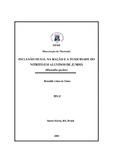| dc.creator | Lima, Ronaldo Lima de | |
| dc.date.accessioned | 2007-12-14 | |
| dc.date.available | 2007-12-14 | |
| dc.date.issued | 2005-02-15 | |
| dc.identifier.citation | LIMA, Ronaldo Lima de. DIETARY SALT AND NITRITE TOXICITY IN SILVER CATFISH FINGERLINGS (Rhamdia quelen). 2005. 60 f. Dissertação (Mestrado em Zootecnia) - Universidade Federal de Santa Maria, Santa Maria, 2005. | por |
| dc.identifier.uri | http://repositorio.ufsm.br/handle/1/10697 | |
| dc.description.abstract | Nitrite is a nitrogenous residue that has several toxic effects on fish, being one of the most important the hemoglobin oxidation, causing hypoxia and death. Therefore, the objective of this work was to verify the survival and growth of silver catfish fingerlings (Rhamdia quelen) exposed to nitrite in the water and fed diets containing different levels of sodium chloride. In the experiment I the 96 h lethal concentrations (LC50-96h) of nitrite were determined using 5 nitrite concentrations in the water for each level of inclusion of NaCl in the food (0, 1, 2, 4, and 6%). In the experiment II the effect of 4 nitrite concentrations was verified (0.06, 0.46, 1.19, and 1.52 mg/L nitrite) for the feed without NaCl addition. The values of LC50-96h for nitrite were 20.46 ± 2.76, 21.37 ± 0.84, 11.86 ± 3.91, 21.37 ± 0.71, and 24.63 ± 4.88 mg/L nitrite, respectively, for the levels of inclusion of NaCl in the food of 0, 1, 2, 4, and 6%. There was no significant difference in relation to survival with the increase of the sodium chloride levels in the food. In the growth experiment 100% mortality rate was observed in the treatment with 1.52 mg/L nitrite after 20 days. Nitrite levels did not change weight, specific growth rate, and food conversion significantly among the treatments after 20 and 40 days. After 40 days the lowest biomass was verified in the treatment with 1.52 nitrite mg/L. The increase of nitrite concentration significantly reduced the standard length and increased the coefficient of variation of weight. The coefficient of variation of length increased significantly with the increase of time of exposure to nitrite. According to the results, the safe level of nitrite for growth of silver catfish fingerlings is below 1.19 mg/L (5,8 % of LC50-96h of the treatment without addition of salt in the food). | eng |
| dc.description.sponsorship | Conselho Nacional de Desenvolvimento Científico e Tecnológico | |
| dc.format | application/pdf | por |
| dc.language | por | por |
| dc.publisher | Universidade Federal de Santa Maria | por |
| dc.rights | Acesso Aberto | por |
| dc.subject | Zootecnia | por |
| dc.subject | Piscicultura | por |
| dc.subject | Jundia | por |
| dc.subject | Dieta | por |
| dc.subject | Alimentação | por |
| dc.title | Inclusão de sal na ração e a toxicidade do nitrito em alevinos de jundiá (Rhamdia quelen) | por |
| dc.title.alternative | Dietary salt and nitrite toxicity in silver catfish fingerlings (Rhamdia quelen) | eng |
| dc.type | Dissertação | por |
| dc.description.resumo | O nitrito é um resíduo nitrogenado que causa nos peixes vários
efeitos tóxicos, um dos mais importante é a oxidação da hemoglobina causando hipóxia e morte. Com isto, o objetivo deste trabalho foi verificar a sobrevivência e o desempenho de alevinos de jundiá (Rhamdia quelen) expostos ao nitrito alimentados com dieta contendo diferentes níveis de cloreto de sódio. No experimento I determinou-se as concentrações letais em 96 h (CL50-96h) de nitrito para cada nível de inclusão de NaCl na ração (0, 1, 2, 4 e 6%). No experimento II verificou-se o efeito de 4 concentrações de nitrito (0,06; 0,46; 1,19 e 1,52 mg/L de nitrito) no crescimento desta espécie, usando uma ração sem adição de NaCl. Os valores das CL50-96h para o nitrito foram 20,46 ± 2,76, 21,37 ± 0,84, 11,86 ± 3,91, 21,37 ± 0,71 e 24,63 ± 4,88 mg/L de nitrito, respectivamente, para os níveis de inclusão de NaCl na ração de 0, 1, 2, 4, e 6%. Não houve diferença significativa em relação à sobrevivência com o aumento dos níveis de cloreto de sódio na ração. No experimento de crescimento verificou-se mortalidade de 100% no tratamento com 1,52 mg/L de nitrito após 20 dias. Analisando o peso, taxa de crescimento específico e conversão alimentar em relação aos níveis crescentes de nitrito, não houve diferença entre os tratamentos aos 20 e 40 dias. Aos 40 dias observou-se biomassa significativamente menor no tratamento com 1,52 mg/L de nitrito quando comparada às demais concentrações. O aumento das concentrações de nitrito diminuiu o comprimento padrão e aumentou o coeficiente de variação do peso. O coeficiente de variação para o comprimento aumentou somente com o aumento do tempo de exposição em todos os tratamentos, com exceção do tratamento com 0,06 mg/L nitrito. Considerando as condições em que se realizou este experimento a concentração de nitrito, em um nível seguro, para o crescimento de alevinos de jundiá fica abaixo de 1,19 mg/L (5,8 % da CL50-96h do tratamento sem adição de sal). | por |
| dc.contributor.advisor1 | Baldisserotto, Bernardo | |
| dc.contributor.advisor1Lattes | http://lattes.cnpq.br/1036046601275319 | por |
| dc.contributor.referee1 | Barcellos, Leonardo José Gil | |
| dc.contributor.referee1Lattes | http://lattes.cnpq.br/4504482634911546 | por |
| dc.creator.Lattes | http://lattes.cnpq.br/7740143050572223 | por |
| dc.publisher.country | BR | por |
| dc.publisher.department | Zootecnia | por |
| dc.publisher.initials | UFSM | por |
| dc.publisher.program | Programa de Pós-Graduação em Zootecnia | por |
| dc.subject.cnpq | CNPQ::CIENCIAS AGRARIAS::ZOOTECNIA | por |


